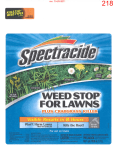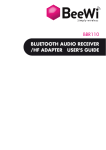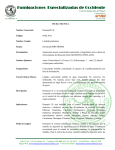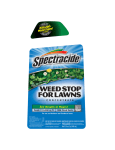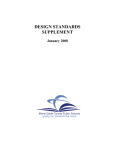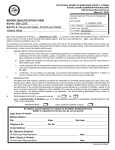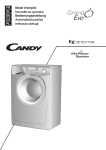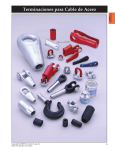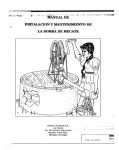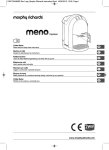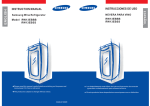Download directions for use
Transcript
478-121-9688_Ace Dilutable Concentrate Lawn Weed Killer_20150317_30_9688.pdf • Cuando utilice un rociador con aplicador tipo manguera o un rociador a presion, evite rocfos demasiado finos porque pueden ser arrastrados y dafiar otras plantas. • Si algunas malezas resistentes no mueren en el plazo de tres semanas, repita el tratamiento. No es necesaria una aplicaci6n al voleo. Siga las instrucciones para el tratamiento localizado. • El uso de este producto cuando las temperaturas del aire son inferiores a los 60°F, puede resultar en un control de las malezas mas Iento. ALMACENAMIENTO VELIMINACION Almacenamiento: Guarde en un Iugar fresco y seco, lejos del calor y del fuego. Si el producto se congela, agite bien antes de usar una vez se haya descongelado. Eliminaci6n: Si esta vacio: Envase no rellenable. No vuelva a usar ni rellenar este envase. Ofnjzcalo para reciclar, si existe esa opci6n. Si esta parcialmente vacio: Llame asu servicio de eliminaci6n de desechos mas cercano para obtener instrucciones de eliminaci6n. Nunca tireel producto sin usar oor ninaun drenaie interno ni extemo. I .CS.IL i.E LD.C II S.C.USIIS IE 31111.1 Riesgos para los seres humanos y los animales domesticos PRECAUCION. causa irritaci6n moderada en los ojos. Nocivo si se absorbe por Ia piel. Nocivo si se ingiere. Evite el contacto con Ia pie!, los ojos y Ia ropa. Use camisa de manga larga, pantalones largos, calcetines y zapatos. Lavese muy bien con agua y jab6n despues de manipula~o y antes de comer, beber, masticar chicle, usar tabaco o usar el bafio. PRIMEROS AUXILIOS Si entra en contacto con los ojos: Mantenga los ojos abiertos y enjuague con agua lentamente, con cuidado, durante 15 a 20 minutos. Si hay lentes de contacto, retfrelos despues de los primeros 5 minutos, luego continue enjuagando los ojos. Llame a un centro de control de envenenamientos o a un medico para recibir instrucciones de tratamiento. Si entra en contacto con Ia piel o Ia ropa: Quitese Ia ropa contaminada. Lave inmediatamente Ia pie! con abundante agua durante 15 a20 minutos. Llame aun centro de control de envenenamientos oa un medico para recibir instrucciones de tratamiento. Si se ingiere: Uame inmediatamente aun centro de control de envenenamientos oaun medico para recibir instrucciones de tratamiento. Si Ia persona puede tragar, haga que beba poco a poco un vaso de agua. No induzca el v6mito amenos que asi se Ia indique un centro de control de envenenamientos o un medico. No administre nada por Ia boca a una persona que haya perdido el conocimiento. Cuando llame a un centro de control de envenenamientos o a un medico, o intente obtener tratamiento, tenga a Ia mano el envase o Ia etiqueta del producto. Tambien puede llamar al 1-800-917-5423 para obtener informacion acerca del tratamiento medicodeurgencia. Nota para el medico: El dafio probable a las mucosas puede contraindicar el usodel lavado gastrico. Riesgos para el medio ambiente Este producto puede ser t6xico para los peces y los invertebrados acuaticos y puede afectar de manera adversa a las plantas que no sean el objetivo. No lo aplique directamente al agua, en aquellas zonas donde exista agua superficial o en zonas intermareales por debajo del nivel promedio de Ia marea alta. El arrastre y el escurrimiento pueden resunar peligrosos para los organismos acuaticos de las zonas cercanas al sitio de aplicaci6n. No contamine el agua cuando elimine las aguas de lavado del equipo ni los residuos del enjuague. Este producto quimico tiene propiedades y caracteristicas relacionadas con sustancias quimicas detectadas en aguas subterraneas. El uso de este producto quimico en zonas de suelos permeables, particularmente donde Ia capa freatica es poco profunda, puede ocasionar Ia contaminaci6n del agua subterranea. La aplicaci6n alrededor de un tanque de agua o un pozo puede contaminar el agua potable osubterranea. 7396096 PEEL HERE Read all instructions inside before using. ABRAAOUI Lea todas las instrucciones dentro antes de usar. ~tCE DILUTABLE CONCENTRATE LAWN WEED KILLER CONCENTRADO DILUIBLE DE HERBICIDA PARA MALEZAS DE CESPED Rainproof in hours A prueba de lluvia en horas Treats 16,000 sq ft Trata 16,0DO pies cuadrados Kills all major broadleaf weeds Mata todas las principales malezas de hoja ancha Kills weed roots Mata las ralces de las malezas NOTICE:.To the extent CQnsis~ent ~ith applicable law, buyer assumes all responsibility for safety and use not maccordance With directions. Questions or Comments? Call1-800-917 -5423. NOTA: Hasta el grado que sea compatible con Ia legislacion pertinente, el comprador asume toda Ia responsabilidad para seguridad y uso que no estlin de acuerdO con las instrucciones. t.Preguntas o c.omentarios? Llame ai1-B00-917-5423. Distributed byChemsico, Division of United Industries Corporation PO Box 142642, Sl Louis, MO 63114·0&12 Manufactured for EPA Reg. No. ~ · 8-121-9688 ~~Est. Nos. 9688:Mi)-1 @, Ace Hardware Corp. 58996-M0-1 11623-GA-1<Q9 11623·GA·3 ~ Oak Brook, Illinois 60523 Circled letter is · 't letter of lot num~r. 17-15297 ©2014UIC ~ USA© 2014 The Ace<~> Promise ~ www.acehardware.com If this Aceproduct when used for itsintended • purpose, falls togive you complete satisfaction, return the Item tothe Ace Hardware store where purchased for free replacement of the same or similar item. El Compromiso de Ace<~> Si este producto Ace, cuando se usa para los fines entendidos, no funciona asu entera satisfaccilin, devUillvalo aIa ferreteria de Ace Hardware donde lo compni para que se lo reemplacen sin costo por uno igual osimilar. TOF OF PURCHASi 0 82901 27325 7 WEEDS CONTROLLED I MALEZAS CONTROLADAS: BROADLEAF WEEDS I MALEZAS DE HOJA ANCHA: •Annual yellow sweetclover • Aster • Austrian fieldcress • Bedstraw • Beggarticks • Betony, Florida • Bindweed, field • Bird vetch • Bitter wintercress • Bittercress, hairy • Bitterweed • Black-eyed Susan • Black medic • Black mustard • Blackseed plantain • Blessed thistie • Bloodlflower milkweed • Blue lettuce • Blue vervain • Bracted plantain • Brassbuttons • Bristly oxtongue • Broadleaf dock • Broadleaf plantain • Broomweed • Buckhorn • Buckhorn plantain • Bulbous buttercup • Bull thistle • Bullnettle • Burclover • Burdock • Burning nettle • Burweed • Buttercup • Buttonweed • Canada thistle • Carolina geranium • Carpetweed • Catchweed bedstraw • Catnip • Catsear • Chickweed, common • Chickweed, mouseear • Chicory • Cinquefoil • Clover, crimson • Clover, hop • Clover, red • Clover, strawberry • Clover, sweet • Clover, white • Cockle • Cocklebur • Common mullein • Cranesbill • Creeping Jenny (Creeping Charlie) • Cudweed • Curly dock • Daisy, English • Daisy fleabane • Daisy, oxeye • Dandelion • Deadnettle • Dichondra • Dogbane • Dogfennel • Dollarweed • Elderberry • English daisy • False dandelion • Falseflax • False sunflower • Rddleneck • Rlaree • Fleabane • Florida pusley • Frenchweed • Galinsoga • Goathead • Goldenrod • Ground ivy • Gumweed • Hairy fleabane • Hawkweed • Healall • Heartleaf drymary • Heath aster • Hedge bindweed • Hedge mustard • Hemp • Henbit • Hoary cress • Hoary plantain • Hoary vervain • Horsenettle • Jimscnweed • Knawel • Knotweed • Kochia • Lambsquarters • Lespedeza • Mallow • Matchweed • Mexicanweed • Milk vetch • Morningglory • Mouseear hawkweed • Mugwort • Musk thistle • Mustard • Narrowleaf plantain • Narrowleaf vetch • Nettle • Orange hawkweed • Oriental cocklebur • Oxalis • Parsley-piert • Parsnip • Pearlwort • Pennycress • Pennywort • Peppergrass • Pepperweed • Pigweed • Pineywoods bedstraw • Plains coreopsis (tickseed) • Plantain • Poison ivy • Poison oak • Pokeweed • Poo~oe • Prairie sunflower • Prickly lettuce • Prickly sida • Prostrate knotweed • Prostrate pigweed • Prostrate spurge • Prostrate vervain • Puncturevine • Purslane, common • Ragweed • Red sorrel • Redroot pigweed • Redstem filaree • Rough cinquefoil • Rough fleabane • Russian pigweed • Russian thistie • Scarlet pimpernel • Scotch thistle • Sheep sorrel • Shepherdspurse • Slender plantain • Smal~lower galinsoga • Smooth dock • Smooth pigweed • Sol iva • Sorrel • Sowthistle • Spanishneedles • Speedwell • Spiny amaranth • Spiny cocklebur • Spiny sowthistie • Spotted catsear • Spotted spurge • Spurweed • Stinging nettle • Strawberry, India mock • Tall nettle • Tall vervain • Tansy ragwort • Tansy mustard • Tanweed • Thistle • Trailing crownvetch • Tumble mustard • Tumble pigweed • Velvetleaf • Venice mallow • Virginia buttonweed • Virginia creeper • Virginia pepperweed • Water pennywort • Wavyleaf bullthistle • Western clematis • Western salsify • White mustard • Wild aster • Wild buckwheat • Wild carrot • Wild four-o'clock • • Wild garlic • Wild geranium • Wild lettuce • Wild marigold • Wild mustard • Wild onion • Wild parsnip • Wild radish • Wild rape • Wild strawberry • Wild sweet potato • Wild vetch • Woodsorrel • Woolly croton • Woolly momingglory • Woolly plantain •Wormseed • Yarrow • Yellow rocket • Yellowflower pepperweed and other broadleaf weeds READ ENTIRE LABEL BEFORE USE. DIRECTIONS FOR USE It is a violation of Federal law to use this product in a manner inconsistent with its labeling. SHAKE WELL BEFORE USING. ~ Do not enter or allow entry until sprays have dried. Precautions and Restrictions: Do not apply this product in a way that will contact workers or other persons either directly or through drift. Only protected handlers may be in the area during application. Do not use this product on or near desirable plants, including within the dripline of the roots of desirable trees and shrubs, since injury may result. The maximum number of broadcast applications per treatment site is two per year with a minimum of 30 days between applications. MEASUREMENT CALCULATIONS Calculate square feet by multiplying length by width. 1fl oz = 2Tbsp (6 tsp); 2fl oz = 4Tbsp; 4 fl oz = Y2 cup; 8 fl oz = 1 cup; 16 fl oz =1 pint; 32 fl oz =1 qt WHEN TO USE 1. SPRING: The best time to treat weeds is when they are small and growing. 2. FALL: Many problem weeds germinate in the fall, and treatment then will eliminate many of next year's weeds. HOW MUCH TO USE SPOT TREATMENT To spray small areas or individual weeds, use a pressure sprayer for better control. Do not use a hose-end sprayer. Mix as directed in table below. Shake well before spraying. Be certain to wet each weed. ENTIRE LAWN PRESSURE SPRAYERS Measure amount of concentrate from chart below into sprayer tank and dilute with 1gal of water. Close tank sprayer and shake well before spraying. Use a spray pattern that gives small spray droplets without any fine mist to treat 250 sq ft. Amount of Concentrate in 1 gal Water Required to Treat 250 sq ft of Lawn (Spot treatment or entire lawn) Grass Type Amount of Concentrate St. Augustine*, Bahia, Centipede Y2fl oz (1 Tbsp) Bermuda, Bentgrass %fl oz (4 tsp) Bluegrass, Fescue, Rye, Zoysia 1 fl oz (2 Tbsp) *DO NOT USE ON FLORATAM VARIETY OF ST. AUGUSTINEGRASS IN FLORIDA. I I HOSE-END SPRAYERS "CONCENTRATE ONLY" (DIAL) SPRAYERS 1. From the chart below determine amount of concentrate to be applied for each 250 sq ft of lawn. 2. Fill sprayer jar with enough concentrate to cover area to be treated. Do not add water to sprayer. 3. Set dial on sprayer to the setting from the chart below. 4. Attach sprayer to hose. Extend hose to the farthest area of lawn to be treated and work back toward faucet so that you do not walk over treated areas. Apply evenly to lawn. Dial Setting Area Treated Ounces in Sprayer Grass Type 250 sq ft }'2 fl oz St. Augustine*, }'2 fl oz Bahia, Centipede 1,000 sq ft 2 fl oz 250 sq ft %fl oz Bermuda, %fl oz 1,000 sq ft Bentgrass 2 %fl oz 250 sq ft 1 fl oz Bluegrass, Rye, 1 fl oz Fescue, Zoysia 1,000 sq ft 4 fl oz *DO NOT USE ON FLORATAM VARIETY OF ST. AUGUSTINEGRASS IN FLORIDA. EXAMPLE: To treat 1,000 sq ft of fescue lawn, add 4 fl oz of concentrate to the sprayer with sprayer dial set on 1 ft oz. Check the directions you received when you purchased your sprayer for further details on the proper use of your dial sprayer. "CONCENTRATE-PLUS-WATER" SPRAYERS For sprayers that require the addition of water as well as concentrate prior to application: 1. From the chart below, determine amount of concentrate required to treat each 250 sq ft of lawn. 2. Pour concentrate into sprayer jar to the required "fl oz" level. 3. Then add the appropriate amount of water to the "gals." level. Replace sprayer top on jar and shake well before spraying. 4. Attach sprayer to hose. Extend hose to the farthest area of lawn to be treated and work back toward faucet so that you do not walk over treated areas.Apply evenly to lawn. Ounces of Concentrate to Use for: Sq ft to be Treated 250 St. Augustine~ Bahia, Centipede Bermuda, Bentgrass Bluegrass, Fescue, Rye, Zoysia Gallons of Water }'2 % 1 1 1,000 2 2% 4 4 5,000 10 13% 20 20 8,000 16 21% 32 32 *DO NOT USE ON FLORATAM VARIETY OF ST. AUGUSTINEGRASS IN FLORIDA. EXAMPLE: To treat 1,000 sq ft of fescue, pour in concentrate to the 4 fl oz mark and add water to the 4 gal mark. Check the directions you received when you purchased your sprayer for further details on the proper use of your sprayer. USE TIPS • For best results, mow lawn before treating weeds. • Do not treat when air temperatures exceed 85°F or damage to grass may occur. • Do not water within six hours of treatment. Poor weed control may result if rainfall occurs within six hours of application. • For new lawns, treat within 24 hours after seeding. On established lawns, wait three weeks after treatment before re-seeding. Once new grass has started to grow, wait until it has reached a height of 2 inches before treating. Treat as directed for newly sodded lawns if weeds are present. • Do not allow spray to get on vegetables or ornamental plants since injury may result. Do not spray around roots of trees and ornamentals. Clover will be damaged if sprayed. • Whether using a hose-end sprayer or pressure sprayer, avoid sprays that are too tine because they can drift and damage other plants. • If certain tough weeds are not dead within three weeks, repeat treatment. Broadcast application is not necessary; follow spot treatment directions. • Use of this product when air temperatures are below 60°F may result in delayed appearance of weed control. STORAGE AND DISPOSAL Storage: Store in a cool, dry area away from heat or open flame. If product freezes, shake well before use once it has thawed. Disposal: If empty: Nonrefillable container. Do not reuse or refill this container. Offer for recycling, if available. If partly filled: Call your local solid waste agency for disposal instructions. Never place unused product down any indoor or outdoor drain. PRECAUTIONARY STATEMENTS Hazards to Humans and Domestic Animals CAUTION. Causes moderate eye irritation. Harmful if absorbed through skin. Harmful if swallowed.Avoid contact with skin, eyes or clothing. Wear long-sleeved shirt, long pants, and shoes plus socks. Wash thoroughly with soap and water after handling and before eating, drinking, chewing gum, using tobacco or using the toilet. FIRST AID If in Eyes: Hold eye open and rinse slowly and gently with water for 15-20 minutes. Remove contact lenses, if present, after the first 5 minutes, then continue rinsing eye. Call a Poison Control Center or doctor for treatment advice. If on Skin or Clothing: Take off contaminated clothing. Rinse skin immediately with plenty of water for 15-20 minutes. Call a Poison Control Center or doctor for treatment advice. If Swallowed: Call a Poison Control Center or doctor immediately for treatment advice. Have person sip a glass of water if able to swallow. Do not induce vomiting unless told to do so by a Poison Control Center or doctor. Do not give anything by mouth to an unconscious person. Have the product container or label with you when calling a Poison Control Center or doctor, or going for treatment. You may also contact 1-800-917-5423 for emergency medical treatment information. Note to Physician: Probable mucosal damage may contraindicate the use of gastric lavage. Environmental Hazards This product may be toxic to fish and aquatic invertebrates and may adversely affect non-target plants. Do not apply directly to water, to areas where surface water is present, or to intertidal areas below the mean high-water mark. Drift and runoff may be hazardous to aquatic organisms in water adjacent to treated areas. Do not contaminate water when disposing of equipment washwaters or rinsate. This chemical has properties and characteristics associated with chemicals detected in groundwater.The use of this chemical in areas where soils are permeable, particularly where the water table is shallow, may result in groundwater contamination. Application around a cistern or well may result in contamination of drinking water or groundwater. • LEA TODA LA ETIQUETA ANTES DE USAR. MODO DE EMPLEO Se considera una violacion a Ia ley federal usar este producto de una manera que no sea Ia indicada en Ia etiqueta. AGITE BIEN ANTES DE USAR. ; : No entre ni perm ita que entre nadie hasta que los rocios se hayan secado. Precauciones yrestricciones: No aplique este producto de modo que entre en contacto con trabajadores ni personas, ya sea directamente o par arrastre. Solo las personas que apliquen este producto con proteccion pueden permanecer en ellugar durante Ia aplicacion. No use este producto en ni cerca de plantas deseables, incluyendo dentro de Ia franja de goteo de las raices de arboles y arbustos deseables, ya que pueden sufrir daiios. La cantidad maxima de aplicaciones al voleo par Iugar se limita ados par aiio con un minima de 30 dias entre aplicaciones. CALCULOS DE MEDICIQN Calcule los pies cuadrados multiplicando Ia longitud par el ancho. 1 onz. liq. = 2 cdas. soperas (6 cdtas.); 2 onz. liq. =4 cdas. soperas; 4 onz. liq. =Y2 taza; 8 onz. lfq. =1taza; 16 onz. lfq. =1 pinta; 32 onz.liq. =1 cuarto de galon CUANDOUSAR 1. PRIMAVERA: La mejor epoca para tratar las malezas es cuando son pequeiias y estan creciendo. 2. OTONO: Muchas malezas problematicas germinan en el otoiio y un tratamiento en ese momenta eliminara muchas de las malezas del proximo aiio. Tipo de cesped San Agustin*, Bahia, Ciempies Cesped Bermuda, Agrostis Pasta azul, Rye, Festuca, Zoysia Area tratada Onzas en el rociador 250 pies2 Y2 onz.liq. Y2 onz.liq. 2 onz.liq. 1,000 pies2 250 pies2 %onz.lfq. %onz.liq. 1,000 pies2 2%onz.lfq. 1 onz.liq. 250 pies2 1 onz.liq. 1,000 pies2 4onz.liq. *NO LO USE EN LA VARIEDAD 'FLORATAM' DEL PASTO SAN AGUSTIN EN FLORIDA. EJEMPLO: Para tratar 1,000 pies cuadrados de cesped Festuca, agregue 4 onz. liq. de concentrado al rociador, con el selector en Ia posicion de 1 onz. lfq. Para mas detalles sabre el uso apropiado de su rociador con selector, revise las indicaciones que recibio al comprarlo. ROCIADORES "PARA CONCENTRADO MAS AGUA" Para rociadores que requieren agregar agua junto al concentrado antes de Ia aplicacion: 1. Utilizando Ia tabla siguiente, determine Ia cantidad de concentrado necesaria para tratar 250 pies cuadrados de cesped. 2. Vierta el concentrado dentro de Ia jarra del rociador hasta el nivel necesario de "onzas liquidas." 3. Despues agregue Ia cantidad apropiada de agua hasta el nivel de "galones." Vuelva aponer Ia tapa del rociador en Ia jarra y agite bien antes de rociar. 4. Conecte el rociador aIa manguera. Extienda Ia manguera hasta ellugar atratar que se encuentre mas alejado y retroceda hacia el grifo mientras Ia aplica de modo de no caminar sabre las zonas tratadas. Aplique uniformemente sabre el cesped. CUANTO USAR TRATAMIENTO LOCALIZADO Para lograr un mejor control, si rocfa zonas pequeiias o malezas individuales, use un rociador a presion. No utilice un rociador con aplicador tipo manguera. Mezcle como se indica en Ia tabla siguiente. Agite bien antes de rociar. Asegurese de mojar cada maleza. TODO EL CESPED ROCIADORES APRESION Mida en el tanque rociador Ia cantidad de concentrado que indica Ia tabla siguiente y diluya con 1 galon de agua. Cierre el tanque rociador y agite bien antes de rociar. Para tratar 250 pies cuadrados utilice un tipo de rocfo que descargue gotas pequeiias pero que no forme niebla. Cantidad necesaria de concentrado en 1 gal6n de agua para tratar 250 pies cuadrados de cesped (Tratamiento localizado 0 todo el cesped) Tipo de cesped San Agustin*, Bahfa, Ciempies Cesped Bermuda, Agrostis Pasta azul, Festuca, Rye, Zoysia Cantidad de concentrado Y2 onz. lfq. (1 cda. sopera) %onz. liq. (4 cdtas.) 1 onz.liq. (2 cdas. soperas) *NO LO USE EN LA VARIEDAD 'FLORATAM' DEL PASTO SAN AGUSTIN EN FLORIDA. ROCIADORES CON APLICADOR TIPO MANGUERA ROCIADORES (CON SELECTOR) "SOLO PARA CONCENTRADO" 1. Utilizando Ia tabla siguiente, determine Ia cantidad de concentrado que se debe aplicar cada 250 pies cuadrados de cesped. 2. Llene Ia jarra del rociador con Ia cantidad de concentrado adecuada para cubrir Ia zona a ser tratada. No agregue agua al rociador. 3. Fije el selector del rociador en Ia posicion de ajuste indicada en Ia tabla siguiente. 4. Conecte el rociador a Ia manguera. Extienda Ia manguera hasta ellugar atratar que se encuentre mas alejado y retroceda hacia el grifo mientras lo aplica de modo de no caminar sabre las zonas tratadas. Aplique uniformemente al cesped. Ajuste del selector Onzas de concentrado a usar para: Pies2 atratar San Agustin*, Bahia, Ciempies Cesped Bermuda, Agrostis Pasto azul, Festuca, Rye, Zoysia Galones de agua 250 Y2 % 1 1 1,000 2 2% 4 4 5,000 10 13% 20 20 8,000 16 21% 32 32 *NO LO USE EN LA VARIEDAD 'FLORATAM' DEL PASTO SAN AGUSTIN EN FLORIDA. EJEMPLO: Para tratar 1,000 pies cuadrados de Festuca, vierta el concentrado hasta Ia marca de 4onz. liq. y agregue agua hasta Ia marca de 4galones. Para mas detalles sabre el usa apropiado de su rociador con selector, revise las indicaciones que recibio al comprarlo. CONSEJOS SOBRE EL USO • Para obtener mejores resultados, corte el cesped antes de tratar las malezas. • No trate las malezas cuando Ia temperatura del aire sea superior a 85°F porque puede daiiar el pasta. • No riegue dentro de las seis horas de efectuado el tratamiento. Si llueve dentro de las seis horas de Ia aplicacion, el control de malezas puede ser deficiente. • Para cespedes nuevos, trate dentro de las 24 horas despues de Ia siembra. En cespedes establecidos, espere tres semanas despues del tratamiento antes de volver asembrar. Cuando el nuevo cesped comience a crecer, espere a que alcance una altura de 2 pulgadas antes de aplicar el tratamiento. Para cespedes nuevas, aplique segun las instrucciones si hay malezas. • No permita que el rocio llegue a las hortalizas o las plantas ornamentales puesto que puede provocarles daiios. No rocie alrededor de las raices de arboles y plantas ornamentales. El trebol resultara dafiado si se rocfa. FIRST AID If in Eyes: Hold eye open and rinse slowly and gently with water for 15-20 minutes. Remove contact lenses, if present, after the first 5 minutes, then continue rinsing eye. Call aPoison Control Center or doctor for treatment advice. If on Skin or Clothing: Take off contaminated clothing. Rinse skin immediately with plenty of water for 15-20 minutes. Call a Poison Control Center or doctor for treatment advice. If Swallowed: Call a Poison Control Center or doctor immediately for treatment advice. Have person sip aglass of water if able to swallow. Do not induce vomiting unless told to do so by aPoison Control Center or doctor. Do not give anything by mouth to an unconscious person. Have the product container or label with you when calling aPoison Control Center or doctor, or going for treatment. You may also contact 1-800-917-5423 for emergency medical treatment information. Note to Physician: Probable mucosal damage may contraindicate the use of gastric lavage. Environmental Hazards This product may be toxic to fish and aquatic invertebrates and may adversely affect non-target plants. Do not apply directly to water, to areas where surface water is present, or to intertidal areas below the mean high-water mark. Drift and runoff may be hazardous to aquatic organisms in water adjacent to treated areas. Do not contaminate water when disposing of equipment washwaters or rinsate. This chemical has properties and characteristics associated with chemicals detected in groundwater. The use of this chemical in areas where soils are permeable, particularly where the water table is shallow, may result in groundwater contamination. Application around acistern or well may result in contamination of drinking water or groundwater. NOTICE: To the extent consistent with applicable law, buyer assumes all responsibility for safety and use not in accordance with directions. Questions &Comments? Call1 -800-917-5423. PRIMEROS AUXILIOS Si entra en contacto con los ojos: Mantenga los ojos abiertos yenjuague con agua lentamente, con cuidado, durante 15 a 20 minutos. Si hay lentes de contacto, retfrelos despues de los primeros 5 minutos, luego continue enjuagando los ojos. Llame aun centro de control de envenenamientos o aun medico para recibir instrucciones de tratamiento. Si entra en contacto con Ia piel o Ia ropa: Quftese Ia ropa contaminada. Lave inmediatamente Ia piel con abundante agua durante 15 a 20 minutos. Llame a un centro de control de envenenamientos o a un medico para recibir instrucciones de tratamiento. Si se ingiere: Uame inmediatamente a un centro de control de envenenamientos oaun medico para rec1bir instrucciones de tratamiento. Si Ia persona puede tragar, haga que beba poco apoco un vasa de agua. No induzca el v6mito amenos que asf se lo indique un centro de control de envenenamientos oun medico. No administre nada par Ia boca a una persona que haya perdido el conocimiento. Cuando !lame a un centro de control de envenenamientos o a un medico, o intente obtener tratamiento, tenga a Ia mana el envase o Ia etiqueta del producto. Tambien puede !lamar al 1-800-917-5423 para obtener informacion ace rca del tratamiento medico de urgencia. Nota para el medico: El dafio probable alas mucosas puede contraindlcar el usa dellavado gastrico. Riesgos para el medio ambiente Este producto puede ser t6xico para los peces y los invertebrados acuaticos y puede afectar de manera adversa alas plantas que no sean el objetivo. No lo aplique directamente al agua,en aquellas zonas donde exista agua superficial o en zonas intermareales par debajo del nivel promedio de Ia marea alta. El arrastre y el escurrimiento pueden resultar peligrosos para los organismos acuaticos de las zonas cercanas al sitio de aplicaci6n. No contamine el agua cuando elimine las aguas de lavado del equipo ni los residuos del enjuague. Este producto quimico tiene propiedades y caracteristicas relacionadas con sustancias quimicas detectadas en aguas subterraneas. El uso de este producto quimico en zonas de sue los permeables, particularmente don de Ia capa freatica es poco profunda, puede ocasionar Ia contaminaci6n del agua subterninea. La aplicaci6n alrededor de un tanque de agua o un pozo puede contaminar el agua potable osubterranea. NOTA: Hasta el grado que sea compatible con Ia legislaci6n pertinente, el comprador asume toda Ia responsabilidad para segundad y uso que no esten de acuerdo con las instrucciones. i,Preguntas ocomentarios? Llame al1-800-917 -5423. Distributed by Chemsico, Division of United Industries Corporation PO Box 142642, St. Louis, MO 63114-0642 EPA Reg. No. 478-121-9688 EPA Est. Nos. 9688-MO-1@, 58996-MO-1@, 11623-GA-1@, 11623-GA-3@ Circled letter is first letter of lot number. 17-15297 © 2014 UIC






